Ginning Cotton
Today, we gin cotton. The University of Houston's College of Engineering presents this series about the machines that make our civilization run, and the people whose ingenuity created them.

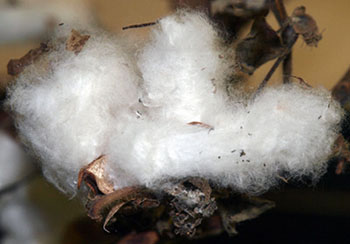 So who invented the cotton gin? Back in 1988, early in this series, I quoted the old myth that Eli Whitney got the idea from a slave. That makes fine historic irony -- too bad there's no basis for it. Now Angela Lakwete traces a history far longer and richer than we might've thought in her book on the cotton gin.
So who invented the cotton gin? Back in 1988, early in this series, I quoted the old myth that Eli Whitney got the idea from a slave. That makes fine historic irony -- too bad there's no basis for it. Now Angela Lakwete traces a history far longer and richer than we might've thought in her book on the cotton gin.
Cotton grows in a cup-like boll that holds maybe 30 seeds. They weigh twice as much as the cotton, which clings to them and makes them very hard to remove. So a five-hundred pound bale of cotton once held a thousand pounds of seed -- or roughly five million individual seeds. Each had to be removed. The other day, I picked up a boll of cotton and set about to remove just one seed. It took twenty seconds to worry it loose. That would mean roughly 13 years of labor to clean a whole bale. Without some sort of mechanical seed-removal, cotton would be a very impractical textile.
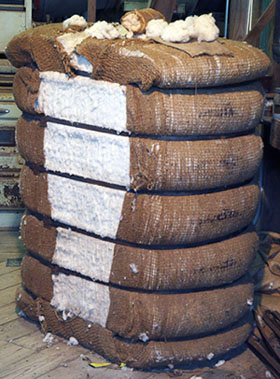
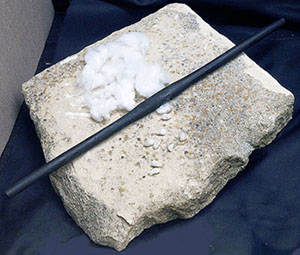 But we've had mechanical aids, ever since the late Stone Age. The earliest cotton gin consisted of a flat stone slab and a skinny hardwood roller. Lay cotton on the slab and grasp each end of the roller. As you roll it over the cotton, the seeds are spit out in front of it. Of course that takes both muscle and skill.
But we've had mechanical aids, ever since the late Stone Age. The earliest cotton gin consisted of a flat stone slab and a skinny hardwood roller. Lay cotton on the slab and grasp each end of the roller. As you roll it over the cotton, the seeds are spit out in front of it. Of course that takes both muscle and skill.
Medieval China and India greatly improved that method with pairs of crank-driven rollers -- like the old washing machine wringer. Then, foot treadles, gearing, flywheels, even water power, were later added to those roller gins. As school children, most of us learned that Eli Whitney took us from picking out seeds by hand, to industrial gins in one step. That clearly did not happen.
Whitney, a bright young Yale graduate, had been given a letter of introduction to a widow, a plantation owner, in South Carolina. There he was to tutor her children. In the process, he struck up a friendship with another Yale graduate, Phineas Miller, who'd previously tutored the children. Lakwete tells us that Whitney and Miller found people concerned with the ginning problem. Whitney came up with the idea of a gin that worked by passing wire claws through cotton to pull it free of its seeds.
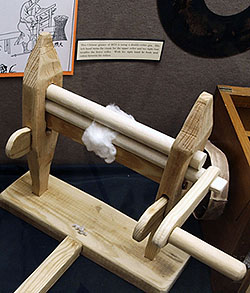 He and Miller formed a partnership in the ginning business, and Whitney obtained a patent in 1794. But, they pointedly blurred explanations of where their idea had come from. They also alienated clients by charging exorbitant fees for ginning. Worse yet, the gin seriously damaged cotton fibers.
He and Miller formed a partnership in the ginning business, and Whitney obtained a patent in 1794. But, they pointedly blurred explanations of where their idea had come from. They also alienated clients by charging exorbitant fees for ginning. Worse yet, the gin seriously damaged cotton fibers.
Two years after Whitney's patent, one Hogden Holmes replaced claws with the much gentler action of a kind of circular saw with tiny teeth that caught fibers and pulled them away from the seeds.
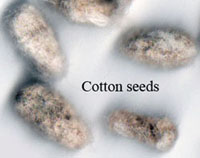 Patent wars soon raged, while roller gins kept competing. Neither Holmes nor Whitney and Miller got rich. And Holmes', not Whitney's, method eventually prevailed. And yet, whatever Whitney did or did not invent, he was certainly a catalyst. Perhaps his greatest contribution was simply stirring the pot in just the right way. After Whitney, big production gins were inevitable.
Patent wars soon raged, while roller gins kept competing. Neither Holmes nor Whitney and Miller got rich. And Holmes', not Whitney's, method eventually prevailed. And yet, whatever Whitney did or did not invent, he was certainly a catalyst. Perhaps his greatest contribution was simply stirring the pot in just the right way. After Whitney, big production gins were inevitable.
I'm John Lienhard at the University of Houston, where we're interested in the way inventive minds work.
A. Lakwete, Inventing the Cotton Gin: Machine and Myth in Antebellum America. (Baltimore: The Johns Hopkins University Press, 2003).
I am grateful to Linda Russell, Director, and Jerry W. Moore, Curator, of the Burton Cotton Gin Museum, Burton, TX, for their extensive and very helpful counsel. All photos taken by J. Lienhard at the Burton Museum.
Apocryphal credit for Whitney's cotton gin idea is often given to either of two people: a slave named Sam whose father had given the idea to him, and Catharine Greene, widow of Revolutionary War General Nathaniel Greene and owner of the South Caroline plantation.
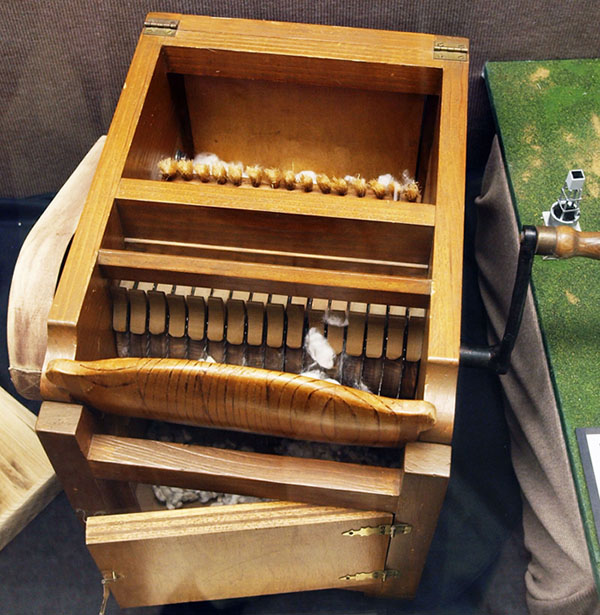
Eli Whitney's original patent burned with the Patent Office in 1836. It was subsequently reconstructed as one of the X Patents. Below is a reconstruction of his original design, but with history rewritten by Whitney's heirs. This model shows Holmes-type saw blades instead of claws.
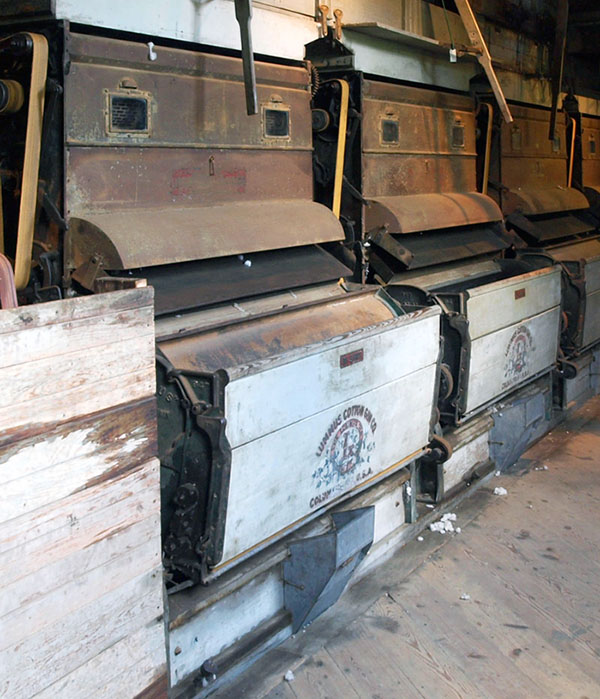
Part of a row of saw-type gins at the 1914 Burton Cotton Gin Museum. The rotor in each gin holds 80 blades.